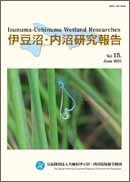Volume 15
Displaying 1-15 of 15 articles from this issue
- |<
- <
- 1
- >
- >|
-
Article type: research-article
2021 Volume 15 Pages 1-13
Published: June 30, 2021
Released on J-STAGE: June 30, 2021
Download PDF (1075K) -
Article type: research-article
2021 Volume 15 Pages 15-23
Published: June 30, 2021
Released on J-STAGE: June 30, 2021
Download PDF (1332K) -
Probable northernmost record in the world range of a semi-aquatic fern genus Ceratopteris from JapanArticle type: brief-report
2021 Volume 15 Pages 25-30
Published: June 30, 2021
Released on J-STAGE: June 30, 2021
Download PDF (852K) -
Article type: research-article
2021 Volume 15 Pages 31-45
Published: June 30, 2021
Released on J-STAGE: June 30, 2021
Download PDF (1147K) -
Records of Asynarchus sachalinensis larvae and their case materials observed in a suburban reservoirArticle type: research-article
2021 Volume 15 Pages 47-59
Published: June 30, 2021
Released on J-STAGE: June 30, 2021
Download PDF (1762K) -
Article type: research-article
2021 Volume 15 Pages 61-77
Published: June 30, 2021
Released on J-STAGE: June 30, 2021
Download PDF (1995K) -
Article type: research-article
2021 Volume 15 Pages 79-86
Published: June 30, 2021
Released on J-STAGE: June 30, 2021
Download PDF (627K) -
Article type: research-article
2021 Volume 15 Pages 87-95
Published: June 30, 2021
Released on J-STAGE: June 30, 2021
Download PDF (818K) -
Article type: research-article
2021 Volume 15 Pages 97-105
Published: June 30, 2021
Released on J-STAGE: June 30, 2021
Download PDF (1696K) -
Article type: research-article
2021 Volume 15 Pages 107-120
Published: June 30, 2021
Released on J-STAGE: June 30, 2021
Download PDF (1250K) -
Article type: research-article
2021 Volume 15 Pages 121-129
Published: June 30, 2021
Released on J-STAGE: June 30, 2021
Download PDF (857K) -
Article type: research-article
2021 Volume 15 Pages 131-137
Published: June 30, 2021
Released on J-STAGE: June 30, 2021
Download PDF (683K) -
Article type: research-article
2021 Volume 15 Pages 139-149
Published: June 30, 2021
Released on J-STAGE: June 30, 2021
Download PDF (1168K) -
Article type: correction
2021 Volume 15 Pages 151
Published: June 30, 2021
Released on J-STAGE: June 30, 2021
Download PDF (111K) -
Article type: other
2021 Volume 15 Pages 152
Published: June 30, 2021
Released on J-STAGE: June 30, 2021
Download PDF (84K)
- |<
- <
- 1
- >
- >|
